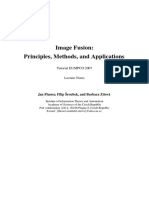Lecture 19
Color Image Processing
�Preview
Why use color in image processing?
Color is a powerful descriptor
Object identification and extraction
e.g., Face detection using skin colors
Humans can discern thousands of color shades and
intensities
c.f. Human discern only two dozen shades of grays
�Preview
Two category of color image processing
Full color processing
Images are acquired from full-color sensor or
equipments
Pseudo-color processing
In the past decade, color sensors and processing
hardware are not available
Colors are assigned to a range of monochrome
intensities
�Color fundamentals
Physical phenomenon
Physical nature of color is known (1666, Isaac Newton)
Chromatic light span the electromagnetic spectrum (EM) from 400
to 700 nm
Physiopsychological phenomenon
How human brain perceive and interpret color?
�Color fundamentals
The color that human perceive in an object =
the light reflected from the object
scene
Illumination source
eye
reflection
�Physical quantities to describe a
chromatic light source
Radiance: total amount of energy that flow from the
light source, measured in watts (W)
Luminance: amount of energy an observer perceives
from a light source, measured in lumens (lm)
Far infrared light: high radiance, but 0 luminance
Brightness: subjective descriptor that is hard to
measure, similar to the achromatic notion of intensity
�How human eyes sense light?
6~7M Cones are the sensors in the eye
3 principal sensing categories in eyes
Red light 65%, green light 33%, and blue light 2%
��Primary and secondary colors
In 1931, CIE(International Commission on
Illumination) defines specific wavelength values
to the primary colors
B = 435.8 nm, G = 546.1 nm, R = 700 nm
However, we know that no single color may be called
red, green, or blue
Secondary colors: G+B=Cyan, R+G=Yellow,
R+B=Magenta
��Application of additive nature of light colors
Color TV
�Application of additive nature of light colors
Color TV
�CIE XYZ model
RGB -> CIE XYZ model
X 0.431 0.342 0.178 R
Y 0.222 0.707 0.071 G
Z 0.020 0.130 0.939 B
Normalized tristimulus values
X
x
X Y Z
Y
y
X Y Z
Z
z
X Y Z
=> x+y+z=1. Thus, x, y (chromaticity coordinate) is
enough to describe all colors
��By additivity of colors:
Any color inside the
triangle can be produced
by combinations of the
three initial colors
RGB gamut of
monitors
Color gamut of
printers
�Color models
Color model, color space, color system
Specify colors in a standard way
A coordinate system that each color is
represented by a single point
RGB model
CYM model
CYMK model
HSI model
Suitable for hardware or
applications
- match the human description
�RGB color model
�Pixel depth
Pixel depth: the number of bits used to
represent each pixel in RGB space
Full-color image: 24-bit RGB color image
(R, G, B) = (8 bits, 8 bits, 8 bits)
�Application of additive nature of light colors
Color TV
�Safe RGB colors
Subset of colors is enough for some application
Safe RGB colors (safe Web colors, safe browser
colors)
(6)3 = 216
�Safe RGB color
�Safe RGB color
Full color cube
Safe color cube
�RGB color model
�CMY model (+Black = CMYK)
CMY: secondary colors of light, or primary
colors of pigments
Used to generate hardcopy output
C 1 R
M 1 G
Y 1 B
�HSI color model
Will you describe a color using its R, G, B
components?
Human describe a color by its hue, saturation,
and brightness
Hue: color attribute
Saturation: purity of color (white->0, primary
color->1)
Brightness: achromatic notion of intensity
�HSI color model
These spaces use a cylindrical (3D-polar) coordinate system to
encode the following three psycho-visual coordinates:
Hue (dominant colour seen)
Wavelength of the pure colour observed in the signal.
Distinguishes red, yellow, green, etc.
More the 400 hues can be seen by the human eye.
Saturation (degree of dilution)
Inverse of the quantity of white present in the signal. A pure colour has
100% saturation, the white and grey have 0% saturation.
Distinguishes red from pink, marine blue from royal blue, etc.
About 20 saturation levels are visible per hue.
Brightness
Amount of light emitted.
Distinguishes the grey levels.
The human eye perceives about 100 levels.
�HSI color model
RGB -> HSI model
Colors on this triangle
Have the same hue
Intensity
line
saturation
�HSI model: hue and saturation
�HSI model
�RGB to HSI
; B G
H
360 ; B G
cos {
1
[( R G ) ( R B)]
2
2
1/2
[( R G) ( R B)(G B)]
S 1
3
[ MIN ( R, G, B)]
( R G B)
( R G B)
I
3
�HSI to RGB
RG Sector
(0H<120):
B I (1 S )
S cos H
R I [1
]
cos(60 H )
G 3I ( R B )
BR Sector
(240H<360):
H H 240
G I (1 S )
GB Sector
(120H<240):
H H 120
R I (1 S )
S cos H
]
cos(60 H )
B 3I ( R G )
G I [1
S cos H
]
cos(60 H )
R 3I ( B G )
B I [1
��HSI component images
R,G,B
saturation
Hue
intensity
��Example 1
Color Image
Hue
Saturation
Luminance
�Example 2
Color Image
Hue
Saturation
Luminance
�Color spaces
RGB (CIE), RnGnBn (TV - National Television Standard Comittee)
XYZ (CIE)
UVW (UCS de la CIE), U*V*W* (UCS modified by the CIE)
YUV, YIQ, YCbCr
YDbDr
DSH, HSV, HLS, IHS
Munsel colour space (cylindrical representation)
CIELuv
CIELab
SMPTE-C RGB
YES (Xerox)
Kodak Photo CD, YCC, YPbPr, ...
Yet there are many such spaces
HSV
described in books.
How does one choose which one
IHS
to use?
triangle
HSI
HLS
��Lecture 20
Color Image Processing
�Pseudo-color image processing
Assign colors to gray values based on a
specified criterion
For human visualization and interpretation of
gray-scale events
Intensity slicing
Gray level to color transformations
�Intensity slicing
3-D view of intensity image
Color 1
Color 2
Image plane
�Intensity slicing
Alternative representation of intensity slicing
�Application 1
X-ray image of a weld
�Intensity slicing
More slicing plane, more colors
�Application 2
Radiation test pattern
8 color regions
* See the gradual gray-level changes
�Gray level to color transformation
�Application 1
�Combine several monochrome images
Example: multi-spectral images
�Rainfall statistics
�Washington D.C.
R+G+B
Near
Infrared
(sensitive
to biomass)
near-infrared+G+B
��Color pixel
A pixel at (x,y) is a vector in the color space
RGB color space
R ( x, y )
c( x, y ) G ( x, y )
B( x, y )
c.f. gray-scale image
f(x,y) = I(x,y)
�Example: spatial mask
�How to deal with color vector?
Per-color-component processing
Process each color component
Vector-based processing
Process the color vector of each pixel
When can the above methods be equivalent?
Process can be applied to both scalars and
vectors
Operation on each component of a vector must
be independent of the other component
�Two spatial processing categories
Similar to gray scale processing studied before,
we have to major categories
Pixel-wise processing
Neighborhood processing
�Color transformation
Similar to gray scale transformation
g(x,y)=T[f(x,y)]
Color transformation
si Ti (r1 , r2 ,..., rn ) , i 1,2,..., n
g(x,y)
s1
s2
sn
f(x,y)
T1
T2
Tn
f1
f2
fn
�Use which color model in color transformation?
RGB CMY(K) HSI
Theoretically, any transformation can be
performed in any color model
Practically, some operations are better suited
to specific color model
��Example: modify intensity of a color image
Example: g(x,y)=k f(x,y), 0<k<1
HSI color space
Intensity: s3 = k r3
Note: transform to HSI requires complex
operations
RGB color space
For each R,G,B component: si = k ri
CMY color space
For each C,M,Y component:
si = k ri +(1-k)
H,S
��Implementation of color slicing
Recall the pseudo-color intensity slicing
1-D intensity
�Implementation of color slicing
How to take a region of colors of interest?
prototype color
Sphere region
prototype color
Cube region
�Application
cube
sphere
�Color image smoothing
Neighborhood processing
�Color image smoothing: averaging mask
1
c( x, y )
K
c( x, y )
( x , y )S xy
R ( x, y )
K ( x , y )S xy
c( x, y )
G ( x, y )
K ( x , y )S xy
K B ( x, y )
( x , y )S xy
vector processing
Neighborhood
Centered at (x,y)
per-component processing
�original
�Example: 5x5 smoothing mask
RGB model
Smooth I
in HSI model
difference
�Example: Image Sharpening
�Lighting conditions
The lighting conditions of the scene have a large
effect on the colours recorded.
Image taken lit by a flash.
Image taken lit by a
tungsten lamp.
�Lighting conditions
The following four images of the same scene were acquired under different lighting
conditions.
�Dealing with Lighting Changes
Knowing just the RGB values is not enough to
know everything about the image.
The R, G and B primaries used by different devices are usually
different.
For scientific work, the camera and lighting should be
calibrated.
For multimedia applications, this is more difficult to
organise:
Algorithms exist for estimating the illumination colour.
























































































